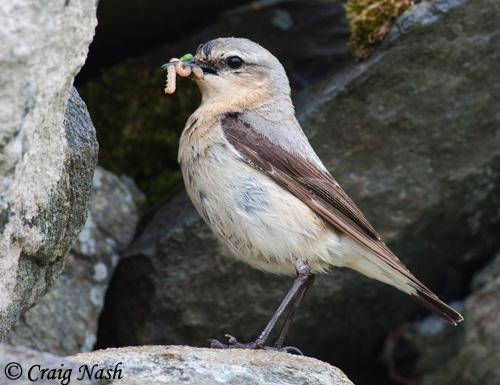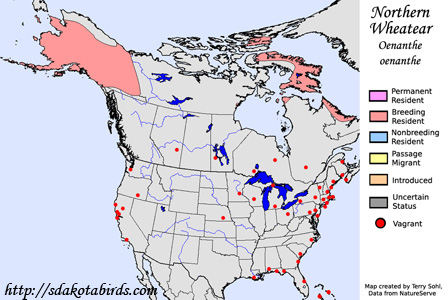| Length: 5.75 inches | Wingspan: 12 inches | Seasonality: Non-resident in South Dakota |
| ID Keys: Obvious white rump and black tail band in flight, gray upperparts, tan/white underparts, black wings, black mask on male | ||
 The
Northern Wheatear is a thrush that breeds on the tundras of Alaska and
Northern Canada. They are rather plain in overall appearance until
they take flight, and the striking black-and-white plumage on the tail
becomes obvious. Northern Wheatears that breed in North America make
one of the longest migratory journeys of any songbird, with birds wintering
in Africa. Birders in the northeastern United States have learned to
keep an eye out for the species in the fall, as vagrants may rarely appear
almost anywhere, and in any habitat.
The
Northern Wheatear is a thrush that breeds on the tundras of Alaska and
Northern Canada. They are rather plain in overall appearance until
they take flight, and the striking black-and-white plumage on the tail
becomes obvious. Northern Wheatears that breed in North America make
one of the longest migratory journeys of any songbird, with birds wintering
in Africa. Birders in the northeastern United States have learned to
keep an eye out for the species in the fall, as vagrants may rarely appear
almost anywhere, and in any habitat.
Habitat: Northern Wheatears in North America typically breed on rocky tundra, preferring dry tundras with dwarf shrubs interspersed with rocks and boulders. During migration, they can be found in almost any open habitat.
Diet: Mostly feeds on insects, as well as spiders and snails. Will also sometimes feed on berries if available.
Behavior: Northern Wheatears do most of their foraging on the ground, scurrying for a few seconds, pausing to look for food, and scurrying forward again.
Nesting: The nests of Northern Wheatears are typically placed in a hole or depression under a rock, in between crevices of rocks in a rocky slope, or in the burrows of small rodents. The nest is made of grasses, moss, and lichens. Both parents help to raise the young.
Song: Song of the Northern Wheatear is a series of rather random-sounding warbles.
Migration: Long-distance migrant. Most birds that breed in North America winter in Africa. Birds in eastern North America typically migrate through Greenland and Europe to Africa, while western North American Birds typically cross the Bering straight into Asia on their way to Africa..
Interactive eBird Map: Click here to access an interactive eBird map of Northern Wheatear sightings
Similar Species: Breeding males unmistakable. Rather plain plumage in females and non-breeders, but Northern Wheatears are still rather dissimilar than other species.
Conservation Status: There are currently no perceived major threats to Bluethroat populations, and Birdlife International cites it as a species of "Least Concern". Breeding populations North America seem to be stable, or perhaps are even increasing.
Further Information: 1) Internet Bird Collection - Northern Wheatear
2) BirdWeb - Seattle Audubon Society - Northern Wheatear
3) AvianWeb - Northern Wheatear
Photo Information: May 27th, 2010 -Inishbofin, County Galway, Ireland - Craig Nash - Licensed under Creative Commons Attribution 2.0 Generic license.
Additional Photos: Additional Photos Coming Soon!!
| Click below for a higher-resolution map |
 |
| South Dakota Status: Non-resident in South Dakota |
Additional Northern Wheatear Photos (coming soon!!)
